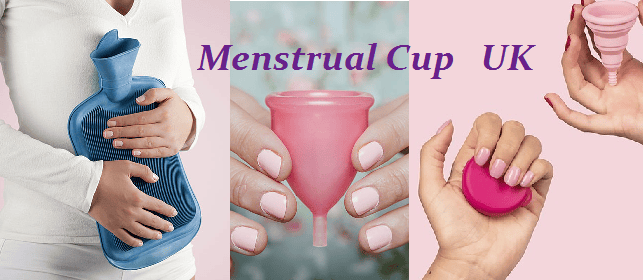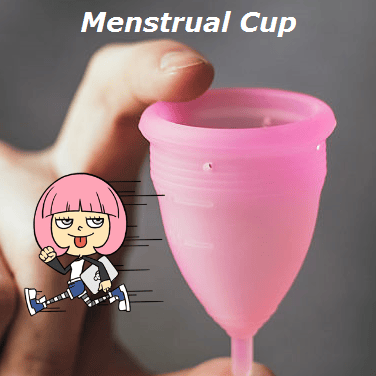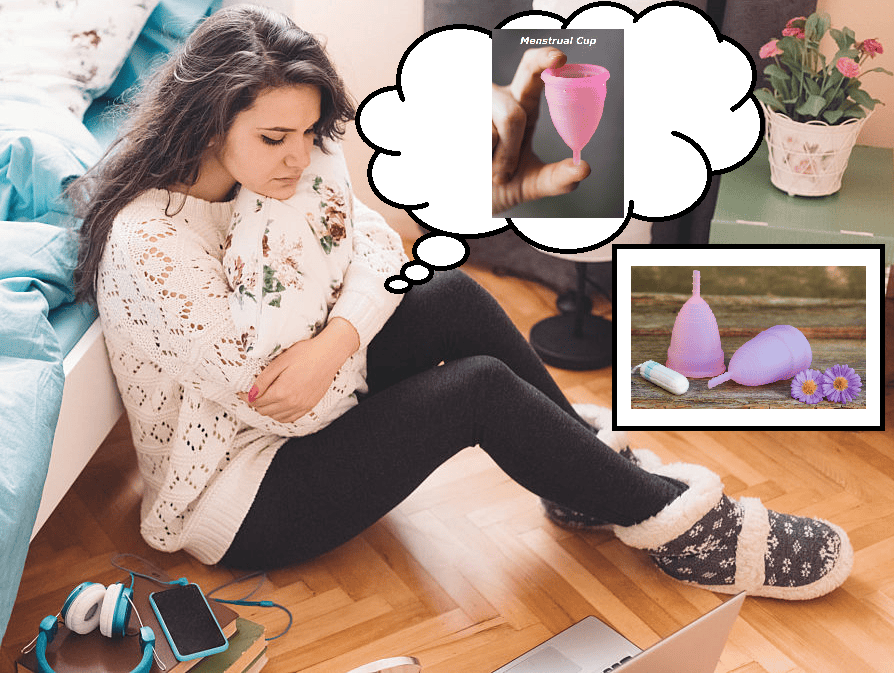What is a menstrual cup?
According to an online medical dictionary* a menstrual cup is “A rubber cup that is inserted into the vagina and placed over the cervix to collect menstrual flow.”
It is a female hygiene product usually made of flexible medical silicone, thermoplastic elastome or rubber and is inserted into the vagina during menstruation to collect menstrual blood. It is an eco-friendly and healthier alternative that a tampon or sanitary pad, and on the contrary it also collects the blood rather than absorbing it. Blood only starts to have an odour when exposed to air and using a menstrual cup should be odour free. Tampons on the other hand absorbs blood with the help of a chemical absorbent and are more likely to cause bacterial infection, dryness of the vagina and bad smells.
If you are latex-sensitive take care to purchase a cup that is entirely made of medical silicone.
Menstrual cups are shaped like a bell with stem to assist with insertion and removal. A menstrual cup is held in place with suction and you can even swim while wearing a menstrual cup. It protects your clothing from stains during menstruation.
A cup can be used for up to 12 hours at a time, but normally you can empty it between 4 – 6 hour intervals and it is also recommended for ladies with heavier flow.
The majority is long-lasting and durable, but you also get disposable menstrual cups. A reusable cup can be used up to 5 years and even though the initial cost is much higher than tampons or other menstrual products the cost is beneficial over the long term saving you money and saving the environment with significantly less waste that would normally be associated with tampons or sanitary pads.
Menstrual cups are available in different sizes and there are a large number of new brands on the market to suite every individual preference.
* The American Heritage® Medical Dictionary Copyright © 2007, 2004 by Houghton Mifflin Company.
Why use a menstrual cup?
Why are women currently raving about alternative period products and in particular the use of a menstrual cup?
During, the past decade more and more focus has been placed on using products that are environmental friendly and even feminine hygiene products are acquiring huge attention with the renewed focus on reusable menstrual cups instead of tampons or sanitary pads.
Even government and private organizations are offering seminars and increasing awareness about the benefits and use of menstrual cups.
WHAT IS A MENSTRUAL CUP? It is a small bell-shaped product made from flexible medical grade silicone. It is reusable and worn in the vaginal canal. Menstrual cups are available in different shapes and sizes, and is used to collect menstrual fluid, which can then be disposed of in the toilet.
The top 5 reasons for switching to a menstrual cup would be:
- Financial benefit / saving money
- Going green
- Convenience and comfort
- Holding more liquid and less leakage & get more hours in between changes
- Medical / health benefits
Let’s look at more detail with regards to each of these:
- Financial benefit of menstrual cups / saving money
I think you will agree with me that disposable period products are rather expensive (that is excluding all the extras such as period pain relief products and even comfort chocolates during “that” time of the month).
Did you know that a woman up to around the age of 52 who does not have kids could have an estimate of 480 periods? Consider using about 22 tampons or sanitary pads each month and that will give you about 10500 sanitary products in your lifetime.
A 41-year-old lady called Denise has saved over £350 in five years while using a reusable silicone menstrual cup.
You could spend between £5-£10 per month which does not sound expensive but multiplied by 12 and by 40 could cost you around £2500+, without inflation or price increases taken into consideration, only on your period products.
Prices for menstrual cups vary from around £7 – £25 and can last for many years, saving you money and saving the planet.
- Going green
Have you ever thought about the amount of waste that is generated from all the tampons, plastic applicators, panty liners and sanitary pads that are being disposed from monthly periods? It is estimated around 200 000 tons wastage per year, with the average menstruater throwing away around 200-300 lbs of disposable period products in her lifetime.
One of the best eco-friendly options to consider if you want to go green with your period is to look at using a menstrual cup you might only use 5 -10 cups in a lifetime instead of 10000+ tampons or sanitary pads.
- Convenience and comfort
Just think about how creative you have been with hiding tampons and sanitary pads all over to always make sure you do not run into an uncomfortable situation, with a menstrual cup you will always have all you need inside your body already (you do not need to smuggle anything extra with you everywhere you go during your periods).
Anyone who has previously used a tampon especially without the applicator would find it very easy to insert and use a menstrual cup (it might take a little bit of practice – remember the discomfort you had and mistakes you made when you first started using tampons).
You also never have to dispose of or must try and hide a tampon while camping or in situations where you don’t know where to dispose it.
If you love travelling a menstrual cup is essential due to the little space it will take.
- Holding more liquid and less leakage & get more hours in between changes
With a tampon or sanitary pad, you most likely must frequently go to the bathroom to check if there is no leakage or must replace it every time you use the toilet.
Most likely with your cycle there might only be one day during which you would have to empty your cup more than once. You could wear a menstrual cup for up to 12 hours. Just imagine putting it in early morning and forgetting about it for the rest of the day until you get home again – you can therefor insert it in the comfort of your own home and take it out in the comfort of your own home.
The estimate volume of an A cup would be about 25ml which will be the equivalent of three super tampons.
- Medical / health benefits
If you buy processed food in a supermarket you get a detailed explanation of all the ingredients but with tampons or sanitary pads there are no regulations to indicate what it is made of and most likely it will only state that it is made of safe absorbent materials.
In the UK most tampons are made with either bleached rayon or cotton or a mixture of both and most likely would contain small traces of dioxin (which is carcinogenic). There is currently a lot of research about the long-term effects and safety of tampons.
Using a menstrual cup will help you to maintain the delicate pH and bacterial balance in your vagina and most likely reduce the risk of bacterial infections like thrush. It also helps some women to have better sexual intercourse due to decreased dryness of the vagina.
Less cramping could also be experienced normally caused in response to the chemicals in a tampon that might be irritating the vaginal wall.
Also less smell due to the fact that a menstrual cup seals inside of you and menstrual fluid does not get in contact with the air.
So, considering some of the above-mentioned reasons, do you think you might consider the option of using a menstrual cup? If yes, please let me know if you have any further questions or if you are willing to test some of the products and give some feedback or reviews (click here to send me an email).
TOP 8 TIPS FOR MENSTRUAL CUP BEGINNERS
TOP 8 TIPS FOR MENSTRUAL CUP BEGINNERS
Are you thinking of replacing disposable menstrual products with menstrual cups? Maybe you’ve just made your first menstrual cup purchase and need some beginner tips to set you off.
Well here is a quick disclaimer. There is no cookie-cutter formula for getting your grip on menstrual cups. Every menstrual cup journey is unique in its own right. On the other hand, strong self-awareness is the secret to unpacking all the incredulous rewards of using cups.
Knowing your body and your preferences will make the experience super easy and fun too.
As a seasoned menstrual cup devotee, I’ve rounded up a few tips for beginners that will help welcome you to the cup life.
- Know Your Body.
How well do you know your body? When it comes to using menstrual cups, having a tight grip on your body structure will make the difference. Female bodies differ in cervix height, menstrual cycles, and pelvic muscle strength.
If you’ve never stuck your fingers up there, then this is a perfect time. You can easily use your fingers to locate your cervix. It feels exactly like the tip of your nose.
This Ruby Cup, for instance, is befitting for women with a high cervix, while this Daisy Menstrual cup is suitable for females with a lower cervix.
- Choose the Right Menstrual Cup.
Typically, we have a variety of menstrual cups dotting the markets. For a beginner user, the process of identifying a befitting cup can be vexing, if not confusing. Nevertheless, this doesn’t have to be the case’ there are enough cups designed for every female.
To make it easier for you, here is a breakdown of some factors that influence the size and shape of cups:
- Age–
You will notice that manufacturers design menstrual cups with specific age brackets in mind. The most probable categorizations you will come across is under 30 and over 30 categories.
For menstruating teenage girls, for example, this Lunette Reusable Menstrual Cup is the ultimate option. Young users hail this small silicone menstrual cup for its unmatched comfort and ease of use. If you are over 30 and have a heavy flow, this DivaCup’s model 2 will suit you best.
- Previous Vaginal Childbirth
While you should not use a menstrual cup during postpartum bleeding, you can use it after you heal. Your pelvic muscles may weaken after birth, prompting you to move up from a size 1 cup to a size 2. However, this isn’t always the case. You can always maintain your cup size so long as your flow remains light.
You can find some top-rate post-birth menstrual cups on Amazon.
- Menstrual flow
Usually, the frequency with which you change your tampon or sanitary towel will dictate the heaviness of your flow. With menstrual cups, you don’t need to worry about your heavier or lighter days.
Menstrual cups can hold up to three times the amount of period blood that a pad or tampon would. Whether you need menstrual cups for regular to heavy flow or for light flow, you will find one.
- Sexual Experience
Can a menstrual cup cause the hymen to break? Yes. Can you use a menstrual cup with zero sexual experience? Also, YES! Thing is, you only lose your virginity when you have sex.
We can’t however discount the fact that inserting a cup or even a tampon can feel awkward for a virgin. On the other hand, virgin females can still wear small-size menstrual cups like these ones without feeling a thing. All you need is to practice being gentle, especially as you insert your menstrual cup.
- Bladder Sensitivity
Does wearing a menstrual cup escalate your trips to the loo? If so, then you have a sensitive bladder. In this case, a menstrual cup manufactured from super soft and flexible silicone would be a prolific option.
This Saalt soft menstrual cup is specifically designed for people with similar sensitivities and severe menstrual cramps. It will hold up for up to 12 hours with no chances of leakage, while still upholding ease on your bladder.
- Relax, It Gets Better With Time.
Let’s face it. Jamming a silicone, bell-shaped object up your vagina during ‘that time of the month’ doesn’t sound interesting. But here’s the thing, tension and anxiety is NOT an option for a first-time cup user. Vaginal muscles tend to tighten under such circumstances, paving way for an awkwardly painful first-time experience.
If you are hoping for an easier, comfortable trial, ensure you are in a super-relaxed mode. For example, you could do it in the shower after a warm, refreshing bath.
- Find a Good Angle For Insertion.
When it comes to inserting menstrual cups, a good angle is paramount. For successful results, you can squat, crouch with one leg raised, or hover over a toilet seat. The right position will enhance proper positioning.
Next, you will need to fold your menstrual cup into half then insert it with the rim facing up. Complete disappearance of the Cup’s stem will be an indication that the cup is in. Try different movements to assess its comfortability.
If the menstrual cup is your size, then the cup will sit in securely. You won’t even notice it’s there.
- Always Lubricate
If you are experimenting while off your period, then you should lubricate the rim of your menstrual cup with water or a water-based lubricant. Do the same to your vaginal opening. This will reduce friction, hence making insertion very comfortable.
Avoid silicone-based lubricants, as they will damage the menstrual cup.
- Always Cleanse Your Menstrual Cup Before and After Use.
If there’s one tip every menstrual cup beginner should grasp, it is menstrual cup hygiene. This object is bound to spend up to 12 hours in your vagina. Since no one likes period odor, cleaning your menstrual cup properly is non-negotiable.
The most recommended cleaning techniques are boiling for up to 20 minutes and using color-free liquid soaps. These techniques will get rid of germs, odor, and stains. You will then have a fresh and longer-lasting cup.
Alternatively, you can use liquid soaps that have no colorings, chemicals or perfumes. Lunette, one of the record-setting menstrual cup brands has one such liquid cleanser.
The Lunette Feel Better Cup Cleanser is simply perfect for sanitizing silicone menstrual cups. Manufactured from chemical-free Lemon and Eucalyptus oils, this cleanser will leave your cup smelling super-fresh. Its PH levels also blend in perfectly with that of your vagina, and you won’t experience any irritations when wearing your menstrual cup.
- Experiment when you are Off Your Periods.
If you’ve never tried a menstrual cup before, a trial is always welcome. I strongly advise that you first try it out when you are off your periods. This will save you from hormonal agitation in case it doesn’t work out perfectly. It will also be less messy since blood won’t be involved.
Once you have inserted your menstrual cup successfully, try walking around your room to have a glimpse on how it feels.
- A Disposable Menstrual Cup Before You Make Your Mind.
Trying out a menstrual cup for the first time sounds like a gamble, especially if you are a menstrual cup beginner. Well if you can’t resist the urge of using one, but you still have your reservations, worry not. Menstrual cups come in reusable and disposable options, although most tend to fall in the former category.
Disposable menstrual cups are cheaper, but still unpack all the benefits of a standard reusable menstrual cup. For a start, try out these soft cup disposable menstrual discs and thank me later.
Making the switch to menstrual cups can be intimidating at a glance, but it shouldn’t be. With
the above prolific tips for menstrual cup beginners, you will have a super-easy time using yours. Welcome to the cup life!




